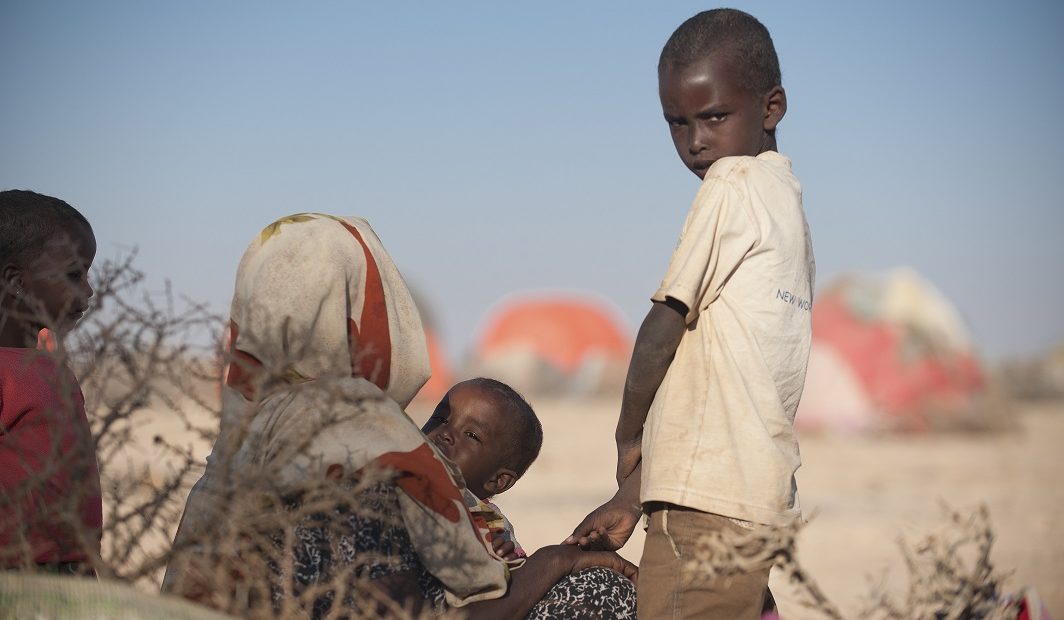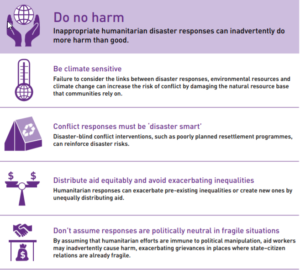From Afghanistan to the Sahel, inhabitants of countries in conflict are often doubly vulnerable to climate risk. On one hand, conflicts limit their adaptive capacity by harming assets needed for adaptation, such as governance institutions, markets and livelihoods. On the other, climate change compounds challenges such as food and livelihood insecurity, poverty and marginalization – which are themselves drivers of conflict – fueling a vicious circle.
More than 50% of people affected by disasters between 2005 and 2009 lived in fragile and conflict-affected areas, a percentage that continues to increase. Yet in many crisis settings, efforts to stabilize conflict dynamics may inadvertently undermine people’s climate resilience or fuel inequalities between groups, thus stoking conflict dynamics. Working to strengthen the resilience of these communities – and importantly, their institutions – to both climate and conflict risk and identifying risk-informed responses to address the different facets of compound hazards is therefore critical. First and foremost, do no harm, and then actively mitigate risks.
Science and technology vs. power and politics
The Fifth Assessment Report (AR5) of the Intergovernmental Panel on Climate Change (IPCC) states that “[p]oorly designed adaptation and mitigation strategies can increase the risk of violent conflict”. All too often, however, we see technical approaches to complex environmental and climate change disasters which do precisely this: they fail to recognize the climate and conflict nexus and thus fail the first rule of any intervention – to do no harm.
While climate change is a predominantly scientific discipline, the solutions to address climate change are inherently political, as are the reasons that some people are more vulnerable to climate change than others (related to a combination of exposure, vulnerability and capacity). Thinking and acting on climate or crises as technical challenges can lock-in some level of path-dependency, gearing responses towards stand-alone technical ‘solutions’, such as drought-resistant seed, disaster-proofed buildings or better irrigation. Policies, programmes and funding in support of climate change adaptation, disaster risk reduction and humanitarian response are subject to the same political interference as development and peacebuilding aid.
If power and politics are not adequately factored in, technical ‘solutions’ will fail.
I’ve personally seen countless examples of climate and disaster responses which do not sufficiently take account of conflict dynamics, power and politics, which in turn become detrimental to peace. In the worst case, they actually harm community resilience, increasing the risk of conflict and climate change. For example, in Lake Chad, to fend off an impending famine, food aid was provided by humanitarian agencies to IDP camps. But the food aid was not accompanied by fuel with which to cook the food. The failure to provide fuel lead to extensive deforestation around the camps for fuel wood. This deforestation undermined the capacity of camp inhabitants to cope with climate change, leading to inundation when the rains came and devastating dust storms during the dry season.
Similarly, in the dryland areas of Kenya, national climate change adaptation policies have been presented in ways which ignore the low-level conflict in these areas, where political exclusion of certain groups, namely pastoralists, has been reinforced by the perceived further marginalization of pastoral culture through adaptation policies. This has fed into pre-existing tensions and insecurity.
People-centred trade-offs
Of course, there are always trade-offs, but to do no harm, these trade-offs need to be climate-risk informed and people-centred. By affecting availability of land and water resources, climate change and conflict heighten trade-offs between say, feeding hungry citizens and other critical policy areas such as growing cash crops for export.
In Rwanda, I met small-holder farmers who traditionally grew diverse crops to hedge against the weather but were encouraged to monocrop high value cash crops (coffee and tea) in line with the national economic strategy. But coffee and tea are not climate proof, and they also undermine the traditional climate resilience and food security of small-holder farmers. As one farmer explained when his coffee crop was ruined by too much rain, when things go wrong, they are left hungry because they cannot eat coffee. And in a fragile, post-conflict setting, these kinds of grievances can be politicized to destabilizing effect. One concrete step would be to conduct climate-fragility risks assessments to find the synergies and trade-offs.
So many tools, so little coherence
There are of course reams of guidelines, standards and tools on how to address climate and environmental risks in humanitarian programming. But a hindrance to their application is the common misperception that taking climate or environmental considerations into account comes at the expense of the humanitarian imperative to save a life.
A UNEP assessment of post-tsunami aid to Aceh showed that the lack of environmental considerations in post-tsunami aid programming – for example through contamination of groundwater through emergency latrine construction, use of unsustainable building materials and inadequate siting of housing – undermined the sustainability of interventions and the long-term resilience of communities. Though conflict did not result in this case, in many fragile contexts there is a very real risk that inappropriate aid interventions, which negatively affect scarce resources such as clean water, can increase the risk of conflict or instability.
The reality is that despite all the tools, the national and international institutional architecture for dealing with conflict, climate and environment tend to run in parallel, not in coordination. This has inhibited joined-up policy on the interconnection between vulnerabilities, risks and opportunities associated with the climate, conflict and environment nexus. Concepts such as resilience and the ‘triple nexus’ have helped bring the idea of ‘interconnectivity’ to the fore, and an increasing number of donors are integrating or mainstreaming individual issues across their policy, programmes and funding decision-making processes. But for the humanitarian sector, conflict remains something of a sticking point – in part because of the complicated links with politics and foreign policy.
What can be done?
As the nature of risk has changed, so too should risk management and response mechanisms. Operationalizing joint climate and conflict risks into crisis programming on-the-ground requires deep understanding of the context and integrated approaches to programme design. This calls for a four-step change to ensure institutions are better able to address linked climate and fragility risks before they spiral into a crisis.
1. Do no harm
Applying a conflict- and climate-sensitive approach to humanitarian responses will minimize harm and can assist in managing conflict risks and risks of maladaptation. Through well-designed interventions, humanitarian agencies can improve trust between different groups, enhance social cohesion and help build resilience. By applying a ‘do no harm’ approach, they can contribute to a reduction of the risk of violence, not through changing ‘what’ is done, but by changing ‘how’ things are done.
2. Financing mechanisms that allow for integrated responses
Humanitarian funding – although currently at a high and growing – is insufficient to meet burgeoning demand. The funding that is available needs to be deployed more effectively. Improved responses through integrated financing can be achieved by: creating and prioritizing hybrid funding streams that are not strictly humanitarian or developmental; enabling more and better cross-sectoral work; providing flexible, accelerated and risk-tolerant funding; and creating financing mechanisms that take account of different needs and timeframes particularly in protracted crises.
3. Learning from each other to truly understand risk and build resilience
The inter-linked nature of risks requires enhancing capacities to undertake joint risk analysis. An important first step is improving the understanding and analysis of local contexts and the nature of risks. The Climate Security Expert Network is a solid step in the right direction here. But risk analysis is not enough. Capacities in national and regional institutions to translate this analysis into conflict- and climate-sensitive responses are equally important.
4. Institutional reform to be ‘fit for purpose’
Meeting climate, development, humanitarian and peacebuilding goals needs more than tools and policy processes. It requires transformation of the very institutions that are tasked with delivering on these promises. To be effective, the UN, bilateral donors and implementing agencies need to reform the silos created by institutional mandates and financial structures. They need to move beyond short-term, project-driven responses and work towards collective, strategic outcomes.
Humanitarian organizations are fully aware of the need to advance a ‘triple nexus’ approach: to align humanitarian, development and peacebuilding actors. However, progressing beyond the innumerable pledges and compacts to bridge the humanitarian-development divide cannot simply depend on good intentions. It requires top-down incentivization, from donors mandating joint programming from funding calls downwards, and from senior management of organizations institutionalizing such practice and creating pragmatic incentives for change in practice, for example through embedding requirements for collaboration into individual job descriptions and performance goals.
From ‘do no harm’ to ‘do some good’
The good news is that these changes don’t require new, additional and different work. It is not about what to do but rather how to improve what we are already doing. It is essentially about connecting the dots, while finding the institutional mechanisms to enable this dot-connecting. A critical dimension of the ‘triple nexus’ approach, for example, is to ensure that climate change is integrated into risk analysis and all programming responses. Nowhere is it more important for the rubber to hit the road on the UN’s ‘new way of working’ than in climate-affected fragile contexts.
See also
- Cécile Aptel, The future is now: time to scale up climate mitigation and adaptation measures, February 6, 2020
- Catherine-Lune Grayson, When rain turns to dust: climate change, conflict and humanitarian action, December 5, 2019







That is great, i also learn a allot from climate crisis and conflict,
Thanks for reading Adamu!
From ‘do no harm’ to ‘do some good’ is the great thing we need to understand risk.
Dear ICRC in world /Specially Horn of Africa we are requesting to you Support because of Poor Community in our Area Regina in Gedo jubaland State Somalia